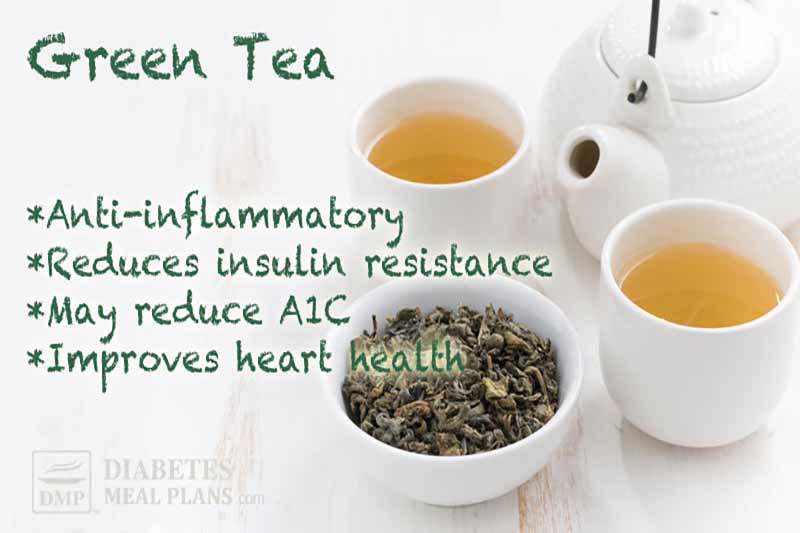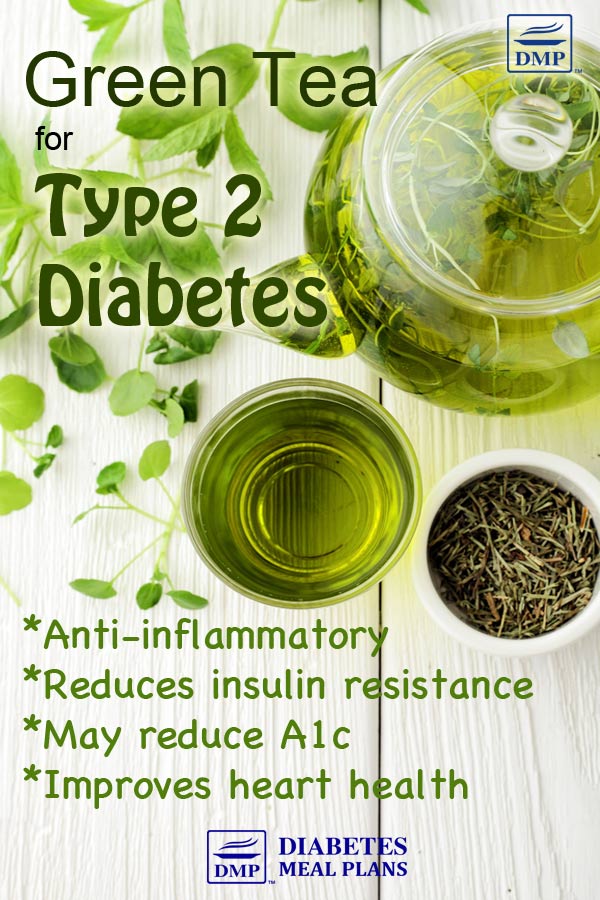There are 2 topics that interest me more than most things, they are inflammation and diabetes. I’d heard that green tea was good for diabetes and in reducing inflammation, so I decided to dig into the research behind green tea, to see if it really is as great as I’ve heard it is.
Here’s what I found.

Nutrient Profile Of Green Tea
Did you know that green tea and black tea are from the same plant?
To tell you the truth, neither did I, but they both come from the ‘Camellia sinensis’ plant. Green tea is unfermented and dried, while the black tea is fermented and treated to get a darker, different tasting tea.
The fermentation process effects the nutrient profile of the tea, having the most impact on the phenolic compounds in the plant, because these are where we get the benefits.
The phenolics in black tea are only 5%, while in green tea they are 30-40%, so that’s a big difference.
|
Green Tea Nutrients |
Green Tea Catechins |
|
|
The catechins found in green tea have been studied for their amazing antioxidant power and have been shown to be:
- anti-mutigenic
- anti-cancer
- anti-diabetic
- anti-inflammatory
- anti-bacterial
- anti-viral
As you can see from the catechins, there is 59% epigallocathechin-3-gallate, and this is the one that has been shown to have some amazing benefits in reducing inflammation, reducing heart conditions, reducing weight gain, helping type 2 diabetes, aiding cancer, and helping arthritis.
The Anti-Inflammatory Effects Of Green Tea
When we get inflammation, our body produces inflammatory cytokines, these are proteins that upregulate the immune response causing more inflammation.
The type of inflammation we’re talking about here is not arthritis, it’s inflammation that occurs at a cellular level. Lots of research now shows that inflammation is contributing to the development of many conditions, including type 2 diabetes.
The catechins in green tea help target those inflammatory cytokines and stop inflammation running wild.
Another thing green tea does is scavenge reactive oxygen species (aka free radicals) and stops pro-oxidant enzymes. What that means is it stops more production of free radicals and this helps slow down the inflammatory process as well.
The powerful anti-inflammatory effects of green tea are what appears to help the most. BUT it also shows many other great benefits as well.
Please pin, tweet or share with others – thanks!

Although some population studies have shown green tea helps lower blood glucose, when researchers have done small trials with type 2 diabetics, the results have been mixed.
Some researchers have found a slight benefit to blood glucose, while others have found no effect.
One thing that the polyphenol ECG might help with is the livers production of glucose. This is one area that often mystifies people, you know, where your morning blood sugar is high or when you haven’t eaten anything? That’s the liver still producing glucose.
So researchers have shown that green tea can help with this and assist in aiding the insulin receptors. And while green tea might not directly influence blood glucose, researchers found that A1C levels were significantly reduced when type 2 diabetics were given green tea extract for 2 months.
Insulin Resistance
A study in rats fed a high fructose diet or a high fructose with green tea diet showed that the rats only fed the high fructose diet developed high blood glucose, high insulin, and high blood pressure. But the rats given the green tea showed improvements in all areas, particularly with insulin resistance. The researchers thought that the GLUT4 transporter involved in helping insulin into the cells was stimulated by the green tea.
When researchers did a trial on humans they didn’t find a direct result like they did in the mice, but they did notice an influence on insulin that suggests further research needs to be done in this area.
Green Tea For Heart Disease
Reactive oxygen species (free radicals) are a major cause of inflammation in heart conditions, and we already established that green tea helps scavenge those, so that’s one great benefit.
Surprisingly green tea also decreases absorption of triglycerides and cholesterol and enhances fat excretion. It also has the added benefit of decreasing the oxidation rate of LDL cholesterol. This is great because oxidized LDL has been shown to be the major contributor to blocked arteries that lead to heart attack and stroke.
Green tea also reduces the adhesion of immune cells to the endothelium (the artery wall). And on top of this green tea produces nitric oxide. This improves vascular function by having a relaxing effect on the arteries. When we don’t have enough nitric oxide we get a constricting effect in our arteries.
“The cardioprotective effect of flavonoids from green tea can be attributed to not only antioxidant, antithrombogenic and anti-inflammatory properties but also improvement of coronary flow velocity reserve”.
And the last thing is it is anti-prolific, meaning it helps stop cells from multiplying so this prevents those lesions that build up in the arteries.
All and all, that means it has some great benefits for heart disease, and since diabetes increases your risk of heart conditions, this can only be a good thing.
So it seems that green tea has multiple beneficial effects across a large variety of conditions and is very beneficial for type 2 diabetics. The effects come mostly through it’s anti-inflammatory capacity but also through a variety of other mechanisms as well.

How Much Green Tea Per Day?
Studies suggest:
- Consuming more than or equal to 3 cups has a 21% decreased risk of stroke
- Daily consumption of 4 or more cups of green tea decreases body weight or body fat
- 5 cups a day produces a 26% decreased cardiovascular deaths
- 1 cup a day reduces coronary artery disease by 10%
So it seems that drinking even 1 cup of green tea a day can provide benefits and drinking a few cups a day is even better.
You might also like to read:
- 5 cinnamon tea recipes – cinnamon is great for metabolism and blood glucose
- Type 2 diabetes diet guidelines
- Diabetes friendly food list
References
Singh R, Akhter N, Haqqi TM. Green tea polyphenol epigallocatechi3-gallate: Inflammation and arthritis. Life Sciences. 2010; 86: 907–918.
Khan N, Mukhtar H. Tea and Health: Studies in Humans. Curr Pharm Des. 2013; 19(34): 6141–6147.
Bhardwaj P, Khanna D. Green tea catechins: defensive role in cardiovascular disorders. Chinese Journal of Natural Medicines. 2013; 11(4): 0345−0353.
Yang CS, Chen G, Wu Q. Recent Scientific Studies of a Traditional Chinese Medicine, Tea, on Prevention of Chronic Diseases. Journal of Traditional and Complementary Medicine 2013; 4(1): 17‑23.

Hannah Schroeder
I like that you mentioned how green tea can reduce the risk of heart disease that diabetes can increase. I’m at risk for hypertension because my mom had it, and I’m also pre-diabetic. Maybe I should buy pure green tea online so I can have plenty to keep me healthy.